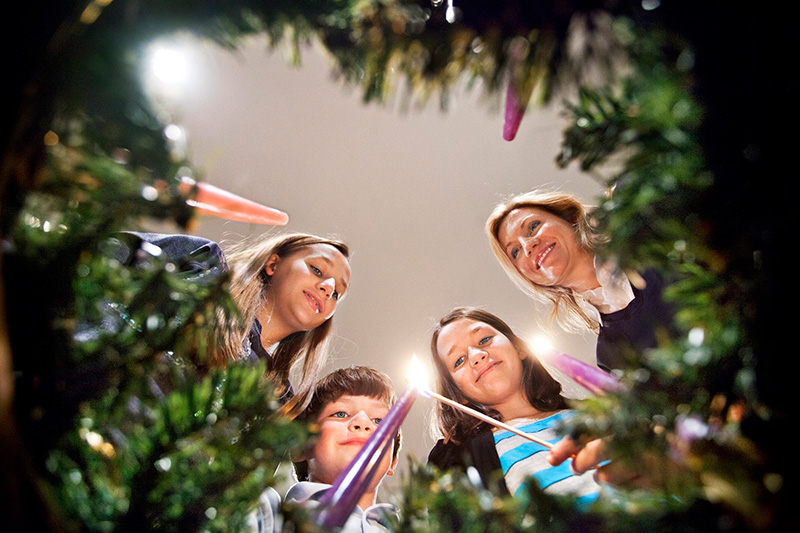 A family lights an Advent wreath at their Maryland home. Catholics are called to exercise a more disciplined approach to our spiritual lives during the four weeks of Advent that begin on Dec. 1 and to pay attention to our words and deeds as we wait for the coming of Christ.
A family lights an Advent wreath at their Maryland home. Catholics are called to exercise a more disciplined approach to our spiritual lives during the four weeks of Advent that begin on Dec. 1 and to pay attention to our words and deeds as we wait for the coming of Christ.
CHARLOTTE — “When we let the world know that there is more to the holiday than presents and decorations, we fulfill our mission as Christians to evangelize the world.”
Imagine expecting a new baby. For months, you prepare to welcome this addition, but in the last month, the preparations really step up. You make sure that the crib is clean, the diapers are in place, the car seat is installed, and family and friends are ready to meet the new baby.
That sense of joyful preparation combined with anticipation is the attitude we bring to Advent as we await the arrival of Christ the Lord. Christmas is the high point, but using the days leading up to Dec. 25 to prepare both spiritually and materially is what Advent is all about.
What sets Advent apart is its spiritual dimension: Advent, which this year begins on Sunday, Dec. 1, is a time of prayer and penance. As Catholics, we are called to exercise a more disciplined approach to our lives during the four weeks of Advent and to pay attention to our words and deeds as we wait for the coming of Christ.
A season of prayer
Waiting is a challenge, but instead of just counting down the days, we are called to use Advent as a time to deepen our relationship with God. Keep things simple: Read a Psalm as a bedtime prayer, go to confession, pray the rosary (especially on the Marian feasts of the Immaculate Conception (this year on Dec. 9) and Our Lady of Guadalupe (Dec. 12), spend some time in Eucharistic adoration, or go to daily Mass.
You could also say the traditional St. Andrew Novena – 25 days of prayer for a holy Christmas, beginning on the feast of St. Andrew, Nov. 30. If you have children, make a “good deed” crèche: Put a slip of paper, acting as a piece of straw, in the manger each time you do a good deed so that the bed will be filled with “holy softness” for the Christ Child.
Signs of the season
Some of the major signs of the season are decorations and lights, especially those on the outside of the house. As you decorate, think about how lights are more than pretty objects. Lights, especially candles, have been used for centuries as a symbol of the star that showed the shepherds and wise men where to find the Christ Child. Your lights can serve as a witness to the “light of the world” that is both coming and has already arrived.
Each household develops their own traditions about when to put up a tree. Some people like to do a little bit over the weeks; others prefer to make decorating a part of Christmas Eve. (And in case you feel as if putting up decorations early is somehow improper, the Vatican puts up its Christmas scene very early in December!)
St. Francis of Assisi is credited with creating the first nativity scene. Invest in having a crèche of your own. Some people put theirs under the tree, others make a special scene on a table.
Some families add a new figure each year.
Tasty traditions
Many families have special foods that they serve only at Christmas. As you prepare these treats, use the time to recall – and pray for – all those family members who have gone before us in death.
You might want to begin building some new and flavorful traditions. One idea from the Anglican tradition is to begin your holiday baking on the last Sunday before Advent. This Sunday is called
“Stir-up Sunday” because traditional fruit cakes were mixed on this day and left to “mellow” until Christmas. The name comes from the Collect prayer from the day’s liturgy: “Stir up, we beseech thee, O Lord, the wills of thy faithful people.” Put a twist on the tradition by making and freezing batches of cookie dough to be baked later.
Advent is a time of hope and light. It is a time when we reaffirm that “nothing is impossible with God,” not even a virgin bringing forth a child. This Advent, find hope as you recommit yourself to spiritual renewal. Look for the Light in everything you do, from shopping to mailing cards to cooking and decorating the house.
Most importantly this Advent, prepare your home and your heart for the coming of Emmanuel, God-with-Us, Jesus Christ.
— Woodeene Koenig-Bricker, OSV News


